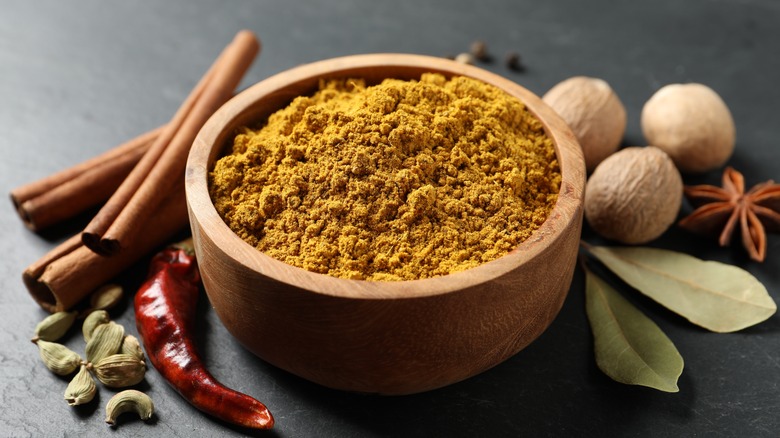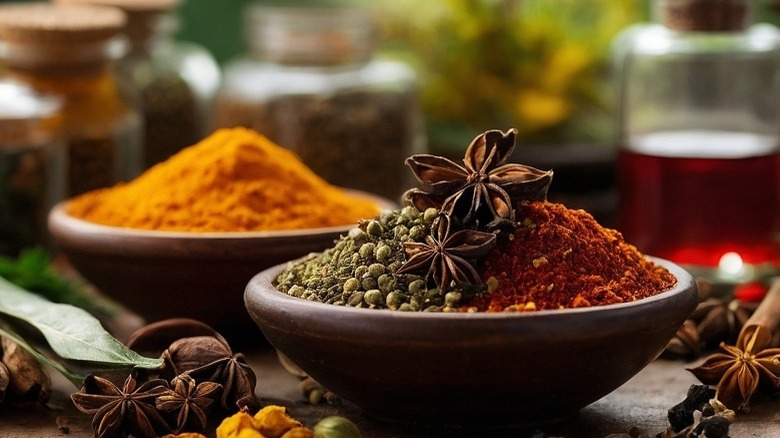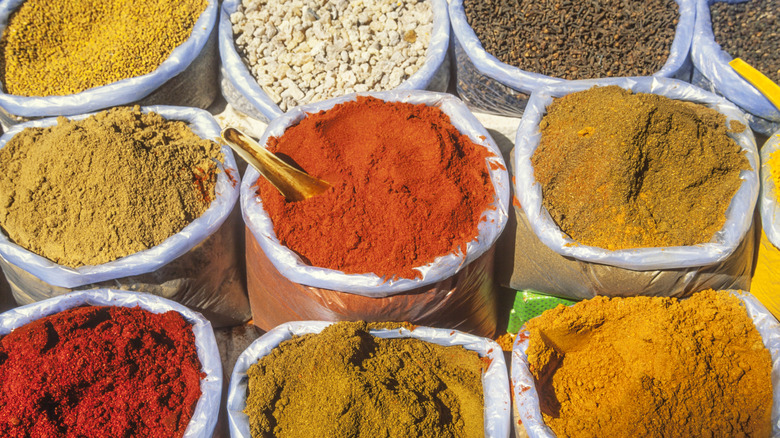What Is Curry Powder Made Of?
Everyone's heard of curry powder, but the common yellow blend you find at your local grocery store doesn't really exist in India. That's because most cooks in this South Asian country mix their own spices, and the resulting spice blends vary by region, household, and even dish.
The closest spice mix you can find in India is garam masala, but that's very different from curry powder. It's usually comprised of black pepper, cumin, cardamom, cinnamon, and clove, whereas what we call curry powder generally includes turmeric, coriander, cinnamon, cumin, black pepper, ginger, cardamom, and fenugreek and is a secret flavor-bomb for a tomato sandwich.
However, curry powder itself is difficult to define, as blends vary worldwide. Our copycat is but a very small piece in a vast but delicious puzzle — a puzzle that involves British colonizers, indentured servants, and innovative Indian businessmen.
How European colonialism created 'curry powder'
The typical yellow mix we call curry powder is the creation British colonialists used to mimic Indian flavors. But people use so many different spices, both throughout India and in Europe historically, that other options exist.
For instance, Madras curry powder, named after the city of Madras (modern-day Chennai) is said to have been created by P. Vencatachellum Pillai and his son, who founded P. Vencatachellum Condiments in 1860. Some of the ingredients were secret, but the brand was known for sourcing red chilies, turmeric, and coriander from India and Bangladesh. While this blend wasn't a hit locally, Pillai found that ship captains and travelers from England enjoyed it, and it eventually became a favorite at Buckingham Palace. That's hardly surprising since it goes so well with Queen Elizabeth's favorite hot sauce.
Meanwhile, vadouvan curry powder is a product of French influence and is based on a precolonization-era spice blend sometimes known as "vadavam" or "vadagam." This blend often combines black mustard seeds, cloves, cardamom, turmeric, cumin, coriander, fenugreek, and Madras curry powder. Similarly, chaat masala has murkier origins, though an (unproven) story links it to the 17th-century Mughal Emperor Shah Jahan. Common in street food in India, this spice blend is typically created with dry mango powder, black salt, cumin, coriander, chili powder, and asafetida, the sap of an herb called ferula, which has a pungent smell but incredible flavor.
The tumultuous history of modern curry powder
The origins of curry powder are intertwined with colonization. In fact, the word "curry" even stems from the Portuguese colonization of Goa in West India, where they took the word "kari," which refers to a spiced dish of meat and vegetables, to mean "spiced stew." This eventually morphed into "caree," which later became "curry" in England, where merchants began bottling spices and labeling them as curry powder to sell to eager Brits who'd previously served in India.
As British influence spread, so too did their curry blends. For instance, the former British colonies of Jamaica, Nevis, and Trinidad and Tobago are known today for their curry dishes. Likewise, through indentured Indian laborers, the British spread curry to parts of Africa, Malaysia, Fiji, and Sri Lanka when the kingdom abolished slavery and the Indian servants were sent to those countries. Similarly, curry was introduced to Japan in the 1800s by the British Navy, who ate a stew made from curry powder gravy, vegetables, and meat. The sailors shared this with the Japanese Navy and now curry is a beloved dish in Japan.
Despite its sometimes dark history, curry powder has become a beloved staple around the world, lending its complex flavor to many a dish, such as curry-spiced turkey burgers, savory veggie or beef stew, and curried deviled eggs with pickled carrots.


